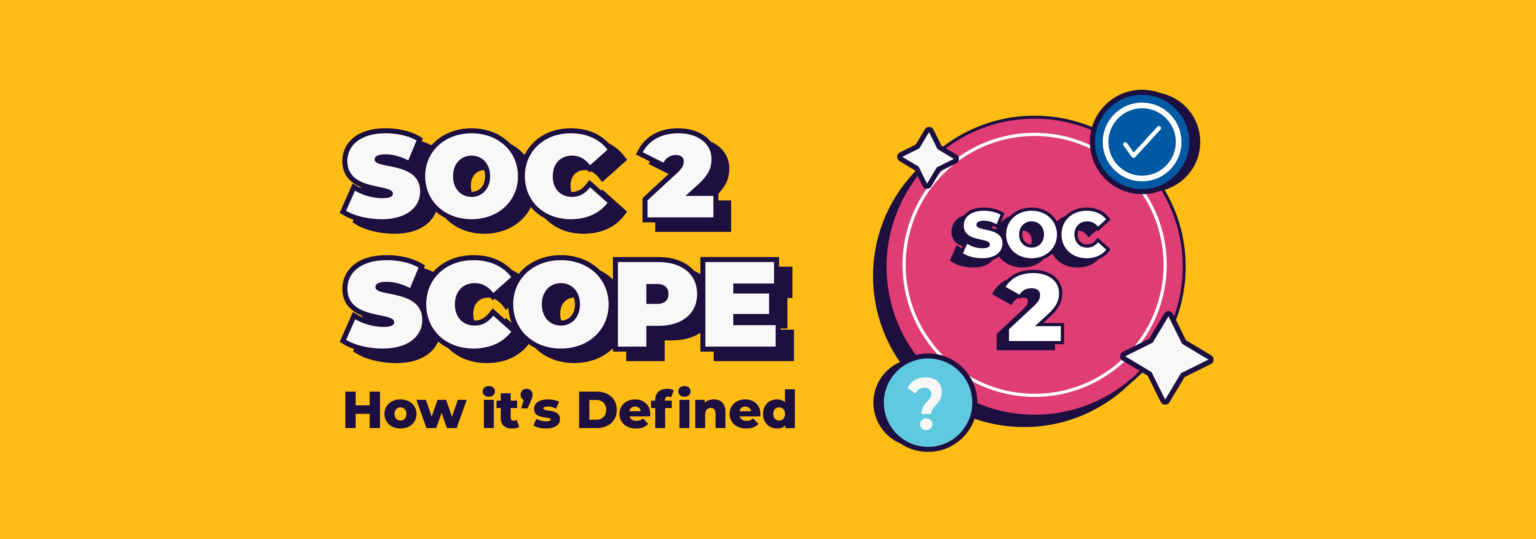One of the reasons SOC 2 is widely praised is due to its flexibility in terms of how organizations implement the relevant controls. However, when defining your SOC 2 scope, many organizations need help navigating what exactly to include in their audit. Why the uncertainty? Well, define the scope too narrowly, and you may not portray the needed assurance your clients look for. A too-narrow scope may also mean you could overlook security risks and leave your business vulnerable.
On the other hand, if your scope is defined too broadly, you may waste essential resources on auditing processes that aren’t all that necessary – not ideal. This could mean that you’re wasting critical resources on implementing controls for threats and vulnerabilities that may not even exist in your organization. Additionally, a too-broad scope significantly lengthens the auditing process and costs more money.
So, is there a ‘right’ way to define your SOC 2 scope? Let’s take a look. But first, let’s refresh and go back to some basics.
What is a SOC 2 Scope?
Defining your SOC 2 scope is a significant step in preparing for your SOC 2 audit. It refers to determining the specific parameters of your internal controls by which you will be assessed under the SOC 2 audit. This scope aims to bring much-needed clarity on controls and systems and lay out everything that should be evaluated to ensure your data security. Your scope will also stand as the essential reference that clients and potential clients will use to satisfy their evolving requirements and set their minds at ease regarding your security posture. It’s a big deal.
Benefits of a Comprehensive SOC 2 Scope
What’s important to note here is that creating a comprehensive SOC 2 scope doesn’t automatically mean broadening your scope. Simply put, it means including the correct information with enough detail to answer the right questions. Easier said than done, right? No worries, we’ll get there in a second. First, let’s touch on how creating a comprehensive SOC 2 scope can benefit your business.
Increased Customer Trust and Confidence
This is probably the most apparent benefit, but it is still one of the main motivations behind achieving a comprehensive SOC 2 scope. It demonstrates that your business has a rock-solid foundation and a solid commitment to security and compliance. It builds trust and confidence amongst potential customers about how their data is handled and protected.
Improved Vendor and Partner Relationships
Security compliance doesn’t end with internal processes. Third-party risk management is crucial for getting (and staying) compliant. A comprehensive SOC 2 scope helps facilitate more transparent relationships with vendors and business partners and holds all parties accountable for their roles and responsibilities to data security.
Market Expansion and Business Growth
A comprehensive SOC 2 scope is a great advantage for businesses operating in global markets. It facilitates entry into new markets with strict data protection requirements and helps showcase your commitment to several key areas of security compliance.
These benefits only scratch the surface regarding how a comprehensive scope and SOC 2 compliance can propel your business while helping you mitigate risk and improve incident response and management.
But how do you get this ideal comprehensive scope we keep going on about? Let’s dive in!
How to Define Your SOC 2 Scope
Although each organization will have its own unique SOC 2 scope, each scope should include a few key elements to ensure that it provides enough information on your internal controls and security processes. This should ideally include information on an organization’s services, systems, policies, processes and people. Remember that you should only have information pertaining to the relevant SOC 2 requirements, which needs to be evaluated against the applicable trust principles – security, availability, processing integrity, confidentiality, and privacy.
Step One: Choose Your Fighters (Trust Services Criteria)
The first step when defining your scope is choosing the relevant trust services criteria that will be included in your SOC 2 audit. Think of it as picking the best players that apply to your specific business operations and industry. These chosen criteria will then serve as the basis for evaluation. The SOC 2 trust service criteria consist of: Security, Availability, Processing Integrity, Confidentiality and Privacy. Each principle includes specific objectives that must be met for an organization to achieve compliance with the standard. However, choosing which TSPs to include in your scope can feel tricky.
To help gauge which TSPs to prioritize, look at each principle and how it aligns with your unique security objectives and priority client concerns. Remember, though, that there’s no debating here when it comes to the Security TSP. The security TSP is the only mandatory principle and must be included in your scope.
Step Two: Identify the Services Included in the Scope
As part of the SOC 2 audit preparation, businesses must specify which services will be included in the audit scope. This entails any service that comes into contact with sensitive data, including collecting, storing, processing and transmitting information. For example, if a business offers services such as cloud computing, managed IT services or data hosting, these must all be included in the scope and how they comply with your relevant TSPs.
Step Three: Include Policies, Procedures, Systems, and Personnel
Another critical component of a comprehensive SOC 2 scope includes the relevant policies, procedures, systems and people associated with collecting, processing, storing or transmitting data. Anything that could affect SOC 2 compliance should be included here. To help create some structure around the process, it’s essential to look at each of these elements a little closer.
| Policies | Include well-documented policies and guidelines that dictate security practices. This includes crucial SOC 2 policies such as vendor management policies and data privacy policies. |
| Procedures | Include your Standing Operating Procedures (SOPs). This refers to the sequential guidance and references for specific operations related to security tasks. An example of this is your company incident response plans and remediation procedures. |
| Systems | Include all technical and physical information systems relevant to chosen trust principles. This includes all devices, software, and network components that collect or process data that are evaluated for managing information security risks. |
| Personnel | Your people are still your first line of defense – include them. Your scope should clearly state all Personnel that are directly responsible for managing particular controls as well as the roles and responsibilities of every employee involved in the process. |
Step Four: What’s your Type?
There are two types of SOC 2 reports: type I and type II. While both SOC 2 reports have similar aims – showcase the security environment of the organization, they differ in scope. Type 2 is generally preferred for organizations looking to provide a higher level of assurance and includes reporting on the design and operating effectiveness of security controls to meet one or more of the chosen TSC over a specified period. Type 1, offers a point in time evaluation and serves as a snapshot only of the design of controls.
GET COMPLIANT 90% FASTER WITH AUTOMATION
From Nope to Perfect Scope with Scytale
Instead of spending time worrying about the dos and don’ts of compliance, replace the heavy-lifting with our automated SOC 2 compliance. Our power duo of tech excellence and human expertise helps you get (and stay) compliant. Our experts will guide you step-by-step of the compliance process and fully prepare you for your audit.
Oh, and don’t forget to check out our podcast!










